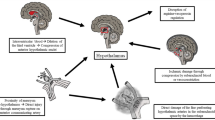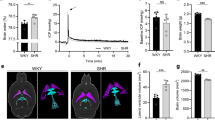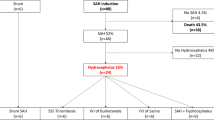Abstract
Hyponatremia is frequent following cranial neurosurgery or acute brain injury like subarachnoid hemorrhage (SAH), and increases mortality by 30%. The pathophysiology is not understood nor does a causal therapy exist. Since clinical trials are potentially dangerous in this very ill population, we examined whether an established rat model allows studying cerebral salt wasting (CSW) following SAH. The daily urine sodium excretion as well as plasma sodium, osmolality and antidiuretic hormone (ADH) levels were measured for 10 days. Following the injection of 300 μl of blood into the great cistern (SAHsevere), natriuresis peaked twice (days 1 and 3–5, p < 0.05) resulting in a plasma sodium nadir (day 1 – 133.9 mmol/L, day 5 – 132.6 mmol/L), while following the injection of 300 μL saline (ICPcontrol), natriuresis occurred delayed on days 4–5 (p < 0.05). Following double SAH (200 μL twice, 24 h apart), a natriuresis on day 4 resulted in a hyponatremia (131.7 mmol/L, p = 0.025). Neither SAHmild (100 μL), the injection of hemolyzed blood (100 μL) or hypertonic saline (200 μL) replicated the effect. The immediate release of ADH (32.23 ± 34.87 pg/mL) following SAHsevere normalized over the next few days. We conclude that first, the rat model of SAH is suitable for studying CSW, second the increase in intracranial pressure generates the delayed hyponatremia, and third, the ADH release does not mediate natriuresis.
Access this chapter
Tax calculation will be finalised at checkout
Purchases are for personal use only
Similar content being viewed by others
References
Costa KN, Nakamura HM, Cruz LR, Miranda LS, Santos-Neto RC, Cosme Sde L, Casulari LA (2009) Hyponatremia and brain injury: absence of alterations of serum brain natriuretic peptide and vasopressin. Arq Neuropsiquiatr 67:1037–1044
Doczi T, Tarjanyi J, Huszka E, Kiss J (1982) Syndrome of inappropriate secretion of antidiuretic hormone (SIADH) after head injury. Neurosurgery 10:685–688
Fraser CL, Arieff AI (1997) Epidemiology, pathophysiology, and management of hyponatremic encephalopathy. Am J Med 102:67–77
Germano A, d’Avella D, Cicciarello R, Hayes RL, Tomasello F (1992) Blood–brain barrier permeability changes after experimental subarachnoid hemorrhage. Neurosurgery 30:882–886
Gill G, Huda B, Boyd A, Skagen K, Wile D, Watson I, van Heyningen C (2006) Characteristics and mortality of severe hyponatraemia – a hospital-based study. Clin Endocrinol (Oxf) 65:246–249
Gul S, Bahadir B, Hanci V, Bektas S, Can M, Kalayci M, Acikgoz S, Acikgoz B (2010) Effect of vardenafil on cerebral vasospasm following experimental subarachnoid hemorrhage in rats. J Clin Neurosci 17:1038–1041
Gullans SR, Verbalis JG (1993) Control of brain volume during hyperosmolar and hypoosmolar conditions. Annu Rev Med 44:289–301
Guresir E, Raabe A, Jaiimsin A, Dias S, Raab P, Seifert V, Vatter H (2010) Histological evidence of delayed ischemic brain tissue damage in the rat double-hemorrhage model. J Neurol Sci 293:18–22
Harrigan MR (2001) Cerebral salt wasting syndrome. Crit Care Clin 17:125–138
Jeon H, Ai J, Sabri M, Tariq A, Macdonald RL (2010) Learning deficits after experimental subarachnoid hemorrhage in rats. Neuroscience 169:1805–1814
Kojima J, Katayama Y, Moro N, Kawai H, Yoneko M, Mori T (2005) Cerebral salt wasting in subarachnoid hemorrhage rats: model, mechanism, and tool. Life Sci 76:2361–2370
Landgraf R, Neumann ID (2004) Vasopressin and oxytocin release within the brain: a dynamic concept of multiple and variable modes of neuropeptide communication. Front Neuroendocrinol 25:150–176
Lee JY, Keep RF, He Y, Sagher O, Hua Y, Xi G (2010) Hemoglobin and iron handling in brain after subarachnoid hemorrhage and the effect of deferoxamine on early brain injury. J Cereb Blood Flow Metab 30:1793–1803
Maesaka JK, Imbriano LJ, Ali NM, Ilamathi E (2009) Is it cerebral or renal salt wasting? Kidney Int 76:934–938
Marbacher S, Fandino J, Kitchen ND (2010) Standard intracranial in vivo animal models of delayed cerebral vasospasm. Br J Neurosurg 24:415–434
Megyesi JF, Vollrath B, Cook DA, Findlay JM (2000) In vivo animal models of cerebral vasospasm: a review. Neurosurgery 46:448–460; discussion 460–441
Mori T, Katayama Y, Kojima J, Moro N, Kawai H, Yoneko M, Kawamata T (2005) Experimental model for investigating hyponatremia after subarachnoid hemorrhage in rats. Acta Neurochir Suppl 95:377–380
Mount DB (2009) The brain in hyponatremia: both culprit and victim. Semin Nephrol 29:196–215
Rabinstein AA, Wijdicks EF (2003) Hyponatremia in critically ill neurological patients. Neurologist 9:290–300
Sherlock M, O’Sullivan E, Agha A, Behan LA, Owens D, Finucane F, Rawluk D, Tormey W, Thompson CJ (2009) Incidence and pathophysiology of severe hyponatraemia in neurosurgical patients. Postgrad Med J 85:171–175
Sherlock M, O’Sullivan E, Agha A, Behan LA, Rawluk D, Brennan P, Tormey W, Thompson CJ (2006) The incidence and pathophysiology of hyponatraemia after subarachnoid haemorrhage. Clin Endocrinol (Oxf) 64:250–254
Thal SC, Sporer S, Klopotowski M, Thal SE, Woitzik J, Schmid-Elsaesser R, Plesnila N, Zausinger S (2009) Brain edema formation and neurological impairment after subarachnoid hemorrhage in rats. Laboratory investigation. J Neurosurg 111:988–994
Conflict of interest statement
We declare that we have no conflict of interest.
Author information
Authors and Affiliations
Corresponding author
Editor information
Editors and Affiliations
Rights and permissions
Copyright information
© 2012 Springer-Verlag/Wien
About this chapter
Cite this chapter
Kleindienst, A., Schlaffer, S.M., Sharma, N., Linde, L., Buchfelder, M., Verbalis, J.G. (2012). Development of an Experimental Model to Study the Pathophysiology of Cerebral Salt Wasting Following Subarachnoid Hemorrhage. In: Schuhmann, M., Czosnyka, M. (eds) Intracranial Pressure and Brain Monitoring XIV. Acta Neurochirurgica Supplementum, vol 114. Springer, Vienna. https://doi.org/10.1007/978-3-7091-0956-4_77
Download citation
DOI: https://doi.org/10.1007/978-3-7091-0956-4_77
Published:
Publisher Name: Springer, Vienna
Print ISBN: 978-3-7091-0955-7
Online ISBN: 978-3-7091-0956-4
eBook Packages: MedicineMedicine (R0)




